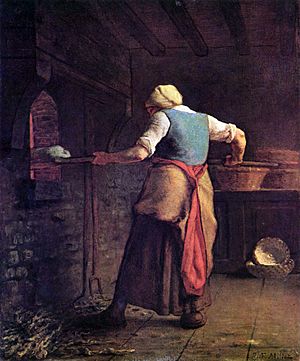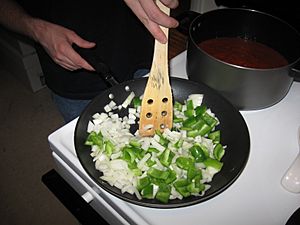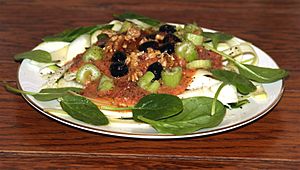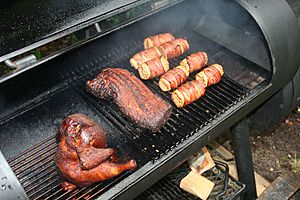Cooking facts for kids
Cooking is the art and skill of preparing food for us to eat. This can be done with or without heat. Cooking styles and ingredients are different all over the world. Some people grill food over a fire, while others use electric stoves or ovens. These differences show off unique traditions, economies, and cultures.
How food is cooked also depends on the cook's skills and training. People cook at home, and professional chefs cook in restaurants. Sometimes, food can even "cook" without heat, like in ceviche. This South American dish uses the acids in lemon or lime juice to prepare fish.
Humans are unique because we prepare food using heat or fire. This might have started about 2 million years ago, but we have strong proof from about 1 million years ago. As farming, trade, and travel grew, cooks found many new ingredients. New inventions, like pottery for boiling water, also helped cooking methods grow. Today, some cooks even use advanced science to make food taste even better!
Contents
History of Cooking

Scientists think early humans might have started cooking between 1.8 and 2.3 million years ago. Evidence from a cave in South Africa shows humans controlled fire about 1 million years ago. There's also proof that Homo erectus was cooking food as early as 500,000 years ago.
Many experts agree that Homo erectus used fire in a controlled way around 400,000 years ago. From 300,000 years ago, we find ancient fireplaces, earth ovens, burnt animal bones, and flint across Europe and the Middle East. Experts believe widespread cooking fires began about 250,000 years ago when hearths (fireplaces) started appearing. Some of the oldest hearths found are at least 790,000 years old!
In the 17th and 18th centuries, food was a big part of identity in Europe. Later, in the 19th century, during the "Age of Nationalism", food became a symbol of a country's identity.
The Columbian exchange greatly changed cooking history. This was when foods moved between the Old World (Europe, Asia, Africa) and the New World (the Americas). Foods like potatoes, tomatoes, corn, beans, chili peppers, chocolate, and pumpkins traveled from the New World to the Old World. This had a huge impact on cooking there. Similarly, foods like cattle, sheep, pigs, wheat, rice, apples, and carrots moved from the Old World to the New World, changing cooking in the Americas.
The Industrial Revolution brought big changes like mass-production and packaging of food. Factories started processing and canning many foods. In the 1920s, freezing methods, cafeterias, and fast-food places became popular.
Governments also started giving advice on healthy eating. The first US guide for healthy eating was in 1916. Later, in 1974, the "food pyramid" was introduced in Sweden to help people eat well.
What's in Our Food?
Most ingredients we cook with come from living things. Vegetables, fruits, grains, nuts, herbs, and spices come from plants. Meat, eggs, and dairy products come from animals. Mushrooms and yeast (used in baking) are types of fungi. Cooks also use water and minerals like salt. Sometimes, wine or other spirits are used too.
Natural ingredients have different amounts of molecules called proteins, carbohydrates, and fats. They also contain water and minerals. Cooking changes these molecules in chemical ways.
Carbohydrates in Cooking
Carbohydrates include sugars like sucrose (table sugar) and simple sugars like glucose (from sugar) and fructose (from fruit). They also include starches found in flour, rice, and potatoes.
When carbohydrates are heated, interesting things happen. Long-chain sugars like starch can break down into simpler sugars. Simple sugars can form syrups. If sugars are heated until all the water is gone, they start to caramelize. This creates a rich, sweet flavor. Also, heating sugars and proteins together causes the Maillard reaction, which gives food a delicious browned flavor.
A mix of starch with fat or water can make dishes thicker when gently heated. In European cooking, a mix of butter and flour called a roux is used to thicken sauces. In Asian cooking, a similar effect comes from mixing rice or corn starch with water. These methods work because starches change during cooking, making sauces thicker.
Fats in Cooking

Fats include vegetable oils, animal fats like butter and lard, and oils from grains like corn and flax. Fats are used in many ways. For example, when you make stir fries or pancakes, you often coat the pan with fat or oil. Fats are also important ingredients in baked goods like cookies and cakes.
Fats can get much hotter than boiling water. This makes them great for cooking methods like frying, deep frying, or sautéing. Fats also add flavor (like butter or bacon fat), stop food from sticking, and create a nice texture.
Proteins in Cooking
Animal foods like meat, milk, and eggs have a lot of protein. Most plant foods, especially legumes and seeds, also contain proteins, though usually less. Mushrooms are also high in protein. These foods give us important amino acids that our bodies need.
When proteins are heated, they change their structure. This often makes the food softer or easier to break apart. For example, meat becomes "cooked" and is less tough. Sometimes, proteins can form firmer structures, like when egg whites become solid. This helps make cakes light and airy, and is key for desserts like meringue.
Water in Cooking

Water is often used in cooking. It can be added to cover food, or it can come out of the food itself. Liquids like water, stock, or wine are very important. Many cooking methods are named after how liquid is used, such as steaming, simmering, boiling, braising, and blanching.
Heating liquid in an open pot makes it evaporate faster. This makes the remaining flavors and ingredients stronger. This is a key part of making stews and sauces.
Vitamins and Minerals in Food
Vitamins are things our bodies need to work properly, but we can't make them ourselves. We get them from food. Examples include Vitamin C (from fruits and veggies), Vitamin A (from carrots and liver), and Vitamin D (from fish oil). Minerals like iron, calcium, and magnesium are also essential in small amounts.
Cooking can sometimes reduce or destroy vitamins and minerals in fruits and vegetables. Vitamin C is easily lost during cooking, especially if cooked for a long time. Peeling vegetables can also lower their Vitamin C content. However, cooking can sometimes help our bodies absorb certain vitamins better, like carotenoids from cooked vegetables. Blanching or steaming vegetables can help keep more vitamins and minerals.
Cooking Methods
There are many ways to cook, and most have been around for a very long time. These include baking, roasting, frying, grilling, boiling, steaming, and braising. A newer method is microwaving. Different methods use different amounts of heat and moisture, and they take different amounts of time. The method you choose greatly affects the final dish. Here are some main hot cooking techniques:
- Roasting
- Roasting – Cooking with dry heat, usually in an oven or over a fire.
- Barbecuing – Cooking food slowly over indirect heat from a fire, often with smoke.
- Grilling/Broiling – Cooking food quickly over direct, high heat.
- Searing – Browning the surface of food quickly at high heat.
- Baking
- Baking – Cooking food with dry heat, especially in an oven.
- Baking Blind – Baking a pie crust or pastry shell without the filling.
- Boiling
- Boiling – Cooking food in water that is bubbling rapidly.
- Blanching – Briefly boiling food, then plunging it into cold water to stop cooking.
- Braising – Cooking food slowly in a small amount of liquid in a covered pot.
- Poaching – Gently cooking food in liquid that is just below boiling.
- Simmering – Cooking food in liquid that is just barely bubbling.
- Steaming – Cooking food using the hot vapor from boiling water.
- Stewing – Cooking food slowly in liquid, usually with smaller pieces of food.
- Frying
- Fry – Cooking food in hot fat or oil.
- Deep frying – Cooking food completely submerged in hot oil.
- Pan frying – Cooking food in a small amount of fat in a pan.
- Sautéing – Cooking food quickly in a small amount of fat over high heat.
- Stir frying – Cooking small pieces of food quickly in a wok or pan while stirring constantly.
- Steaming
- Steaming works by boiling water to create steam. This steam then heats and cooks the food. Many people think steaming is a healthy way to cook because it helps keep nutrients in vegetables and meat.
- En papillote – Food is placed in a sealed pouch (like parchment paper) and then baked. The food cooks in its own moisture.
- Smoking
- Smoking is a way to flavor, cook, or preserve food by exposing it to smoke from burning wood or other materials.
Health and Safety in Cooking
Food Safety
Cooking can stop many foodborne illnesses that you might get from eating raw food. When food is heated, it can kill harmful germs like bacteria and viruses, as well as parasites. Food poisoning can be caused by bacteria like Escherichia coli or Salmonella typhimurium. Parasites can come from salads, undercooked meat, or unboiled water.
How well cooking kills germs depends on the temperature, how long you cook, and the method used. Some bacteria can form spores that survive boiling. These spores can then grow back after the food cools. This is why it's not safe to reheat cooked food more than once.
Cooking also makes many foods easier to digest or safe to eat that would be harmful raw. For example, raw kidney beans are toxic but become safe after cooking for at least ten minutes at 100°C (212°F).
To keep food safe, you need to prepare, handle, and store it correctly. Bacteria that spoil food grow quickly in the "Danger zone" temperature range (4°C to 60°C or 40°F to 140°F). Always wash your hands and cooking surfaces, especially after handling raw meat. Keep raw food separate from cooked food to avoid spreading germs. Washing and cleaning cutting boards, especially after using them for raw meat, poultry, or seafood, helps a lot.
How Cooking Affects Nutrients
Some people who eat only raw food believe that cooking can harm food or health. They point out that vitamin C in vegetables and fruits can be lost during cooking, especially if it dissolves into the cooking water or is destroyed by air. Peeling vegetables can also reduce vitamin C. However, studies show that cooking can help our bodies absorb some nutrients better, like carotenoids from cooked vegetables. Blanching or steaming vegetables can help keep more vitamins and minerals.
Carcinogens and Cooking
Research shows that grilling, barbecuing, and smoking meat and fish can create certain chemicals called polycyclic aromatic hydrocarbons (PAHs). These chemicals can be harmful. In some parts of the world, grilled and smoked foods are a small part of people's diets, so they don't contribute much to PAH intake. However, in the US, grilled/barbecued meat is a bigger source of a known harmful PAH.
Baking, grilling, or broiling starchy foods until they form a toasted crust can create a chemical called acrylamide. This chemical has been linked to cancer in animal studies, but its risk to humans from normal eating is not fully clear. Health experts suggest reducing this risk by avoiding overly browning starchy foods or meats when frying, baking, toasting, or roasting them.
Other Health Considerations
Heating sugars with proteins or fats can create "glycotoxins." These have been linked to aging and health issues like diabetes and obesity.
Deep-fried food, especially from restaurants, might contain high levels of trans fat. Trans fats are known to increase bad cholesterol, which can raise the risk of heart diseases. However, many fast-food chains now use trans-fat-free oils for deep-frying.
Science in Cooking
Applying scientific knowledge to cooking and gastronomy is called molecular gastronomy. This is a part of food science. Many scientists, chefs, and authors have made important contributions to this field, like Herve This, Nicholas Kurti, Harold McGee, and famous chefs like Heston Blumenthal and Ferran Adria.
Cooking at Home vs. Commercial Cooking
Cooking at home has always been a common activity, often enjoyed by everyone in the family. In many cultures, women traditionally took the main role in home cooking. Cooking also happens outside the home, like in restaurants or schools. Bakeries were some of the first places to cook food outside the home. In the past, bakeries even offered to cook food that customers brought in their own pots.
Today, factory-prepared food is very common. Many "ready-to-eat" foods are made and cooked in factories. People at home often use a mix of homemade and factory-made foods for their meals. Studies have shown that meals with more commercially prepared foods are often less healthy than home-cooked meals. Home-cooked meals tend to have fewer calories, less unhealthy fats, and less salt. They also often provide more fiber, calcium, and iron. When you cook at home, you also control the ingredients, so you know what you're eating.
"Home-cooking" is often linked to comfort food. Some store-bought foods are even advertised to look like they were "home-cooked," even if they weren't.
Commercial cooking methods have also changed a lot. Many of the ingredients and techniques used at home are now used in restaurants, and customers really enjoy them.
Images for kids
-
Pots being heated to cook food in a dwelling in South India
See also
 In Spanish: Cocción para niños
In Spanish: Cocción para niños









